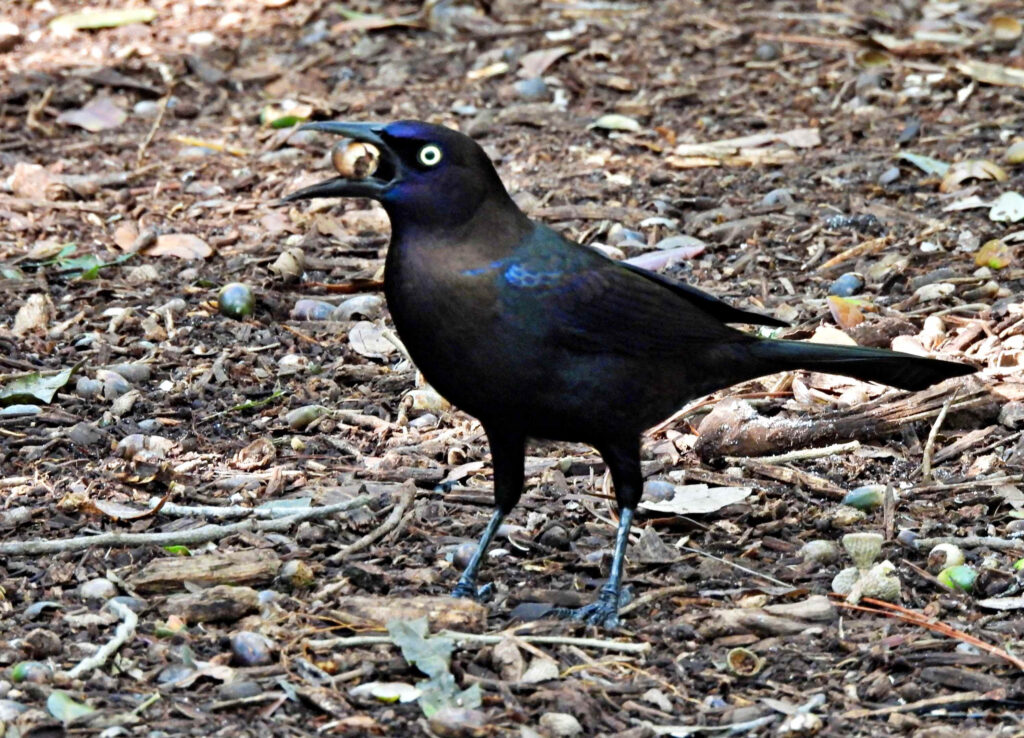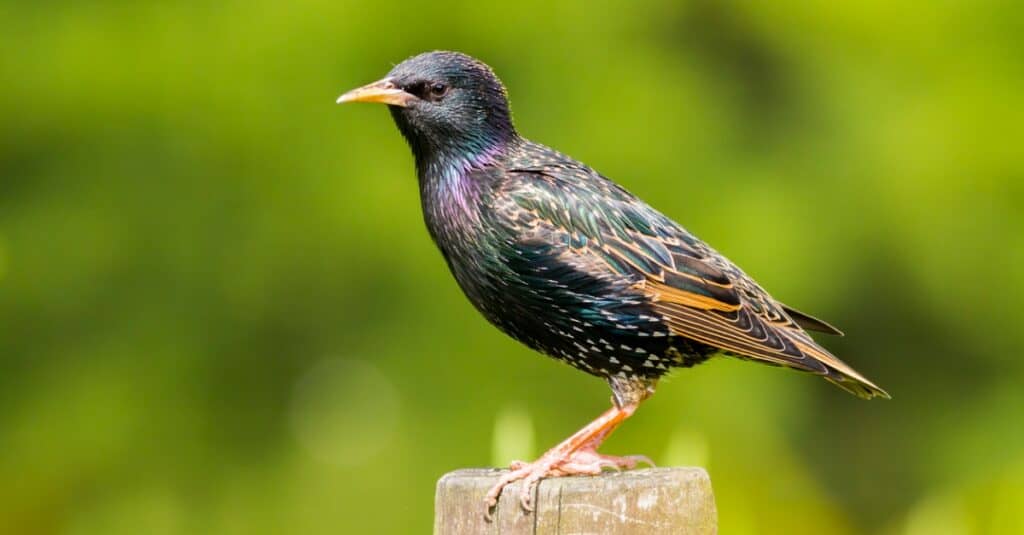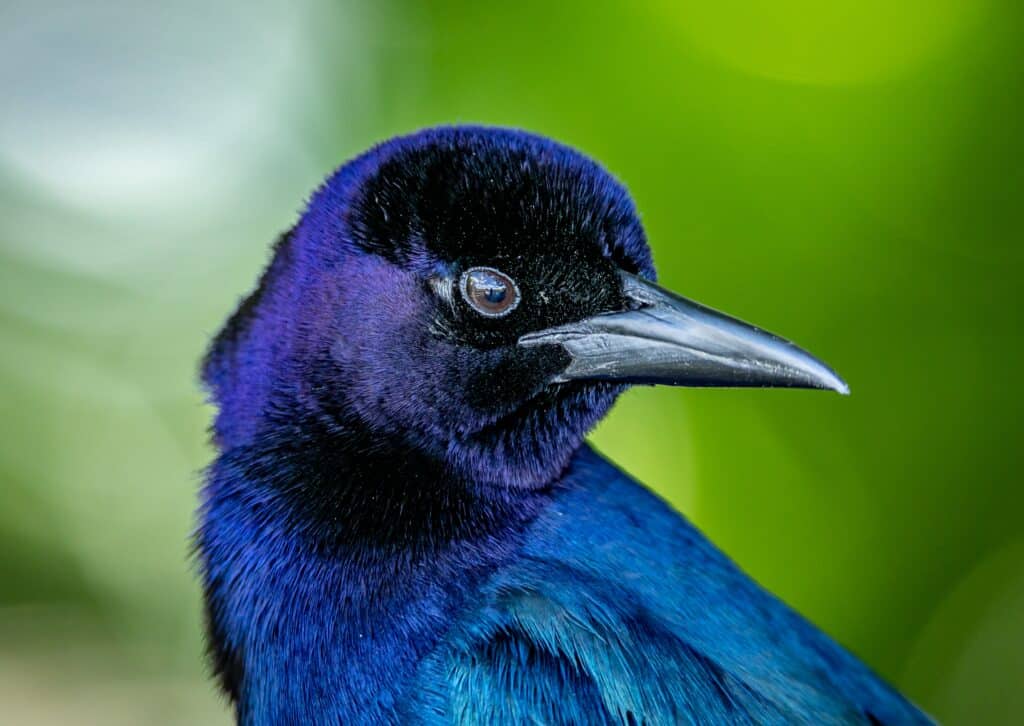Key Points:
- Grackles and starlings are both passerine songbirds that live in similar habitats.
- Both grackles and starlings feature dark, iridescent feathering.
- These social birds live in large groups and will occasionally flock together.
The common grackle (Quiscalus quiscula) and common starling (Sturnus vulgaris) are dark-colored songbirds distributed widely throughout the United States. While avid bird watchers can probably spot the differences between these birds, you may struggle to tell one from the other. If you question whether the bird at your feeder is a grackle vs. starling, then this guide is for you.
Grackle vs. Starling

A common grackle with a seed in its mouth. Many people have difficulty telling grackles and starlings apart.
©iStock.com/passion4nature
Grackles and starlings both belong to the passerine or perching bird order Passeriformes. While these dark-colored songbirds share numerous similarities, they are quite different.
Let’s examine a few traits that separate grackles vs. starlings, including their size, features, coloration, and range.
Comparing Grackle vs. Starling
| Grackle | Starling | |
|---|---|---|
| Size | 11 to 13 inches | 7.5 to 9 inches |
| Eyes | Pale yellow eyes | Dark eyes |
| Legs | Dark legs | Pink legs |
| Bill | Thick dark bill | Slender yellow (or black bill |
| Tail | Long tail | Short tail |
| Coloration | Dark, iridescent plumage | Dark or brown plumage with spots |
| Range | Eastern North America | Africa, Europe, and Asia (native)North and South America, Australia (introduced) |
The 7 Key Differences Between Grackles vs. Starlings
Grackle vs. Starling: Size
At first glance, grackles and starlings appear roughly similar in size. However, when you compare them side by side, you’ll quickly see that grackles measure noticeably larger than starlings.
On average, adult common grackles measure between 11 and 13 inches long. They sport a wingspan of 14 to 18 inches and weigh between 2.6 and 5 ounces. Males typically measure larger than females.
Meanwhile, common starlings generally measure from 7.5 to 9 inches long. Their wingspan usually measures between 12 and 17 inches, and they weigh from 2 to 3.6 ounces.
Grackle vs. Starling: Eyes

European starlings have glossy, iridescent feathers and dark eyes.
©iStock.com/chris2766
If you can’t tell the difference between a grackle vs. starling, look no further than the eyes. After all, the eyes are the windows to the soul. They can also help you quickly recognize these two songbirds.
Common grackles possess pale yellow eyes with dark irises. Meanwhile, common starlings feature dark eyes.
Grackle vs. Starling: Legs
In case you can’t get close enough to look a grackle or starling in the eye, try to catch a glimpse of its legs. Doing so will quickly let you know whether the bird in your backyard is a grackle or a starling.
Grackles have dark legs that appear gray or black. On the other hand, starlings have pink legs. That said, immature starlings have grayish legs.
Grackle vs. Starling: Bill

Grackles have black bills, while starlings have black bills in winter and yellow bills in summer.
©Holly S. Cannon/Shutterstock.com
This next difference that separates grackles vs. starlings varies depending on the time of year. Still, spotting bill differences ranks as one of the easiest ways to differentiate a grackle and a starling.
Grackles have thick, dark gray or black bills. The upper part of the bill sports a slight but noticeable downward curve.
As for starlings, their bills change color depending on the season. In winter, the long, slender bill appears black, while in summer, it looks yellow. Therefore, you’ll likely have an easier time differentiating grackles and starlings by their bills in summer than in winter.
Grackle vs. Starling: Tail
To the untrained eye, grackles and starlings have very similar-looking tails. However, look again, and you should spot a few key differences that separate the two.
Grackles sport long tails that can measure nearly as long as the length of their bodies. That said, we should note that females typically have shorter tails than males. When in flight, the tail can sometimes reveal a small orange patch.
Meanwhile, starlings sport relatively short tails. On average, a starling’s tail measures between 2.3 to 2.7 inches long.
Grackle vs. Starling: Coloration

Unlike grackles, starlings feature speckled feathers.
©Estudax/Shutterstock.com
It’s tempting to say that grackles and starlings look the same. While they certainly sport similar plumage, several differences separate the two.
Grackles have predominantly black feathers on the wings, back, and belly. Meanwhile, the head, neck, and breast feathers feature a blue, green, or purple iridescent sheen. Juvenile grackles look primarily brown.
Like grackles, starlings possess primarily iridescent black plumage glossed with green or purple and flecked with white speckles. However, their plumage changes color from winter to summer. Starlings look most similar to grackles in winter when their plumage appears more speckled and their bills turn black. Meanwhile, in summer, they lose their speckled feathers, and their bills turn yellow. Similar to grackles, juvenile starlings appear mostly grayish-brown.
Grackle vs. Starling: Range
Today, you can often find grackles and starlings living side-by-side. In fact, they will sometimes even flock together. However, this is a relatively recent phenomenon. Historically, these birds lived in different environments and only started to live in proximity to one another thanks to the intervention of humans.
You can find grackles throughout the eastern half of North America. Specifically, their range extends east from the Rocky Mountains to the Atlantic Ocean and from central Canada to southern Texas. You can typically find grackles living year-round in the eastern United States. Meanwhile, some populations breed in Canada or the central United States and then travel south for the winter. Grackles tend to breed in open or in semi-open areas. They build their cup nests in trees or shrubs and often choose nesting locations near water.
Starlings are native to Asia, Europe, and northern Africa. You can find them year-round in central Europe as well as part of the middle east. In summer, migrating populations live in central Asia and eastern and northern Europe. These populations then migrate to northern Africa, the Iberian Peninsula, India, and the Levant in winter. Common starlings first arrived in North America during the 19th century. According to some accounts, Shakespeare enthusiasts released over 100 starlings in Central Park, New York, in 1890. Fast forward 100 years, and experts today estimate the common starling population in North America at 200 million birds. Starlings have also been introduced to parts of Australia, New Zealand, South Africa, and Argentina.
The photo featured at the top of this post is ©
Thank you for reading! Have some feedback for us? Contact the AZ Animals editorial team.






